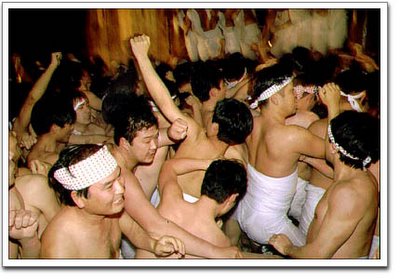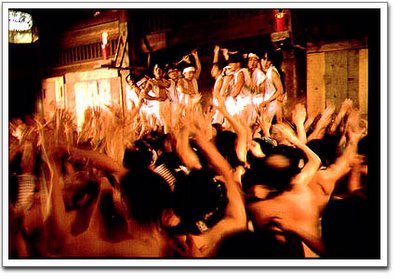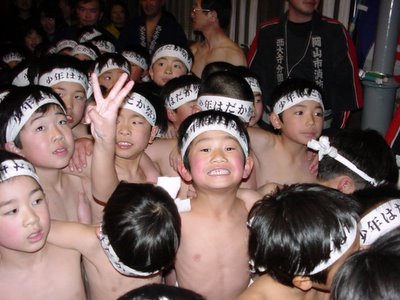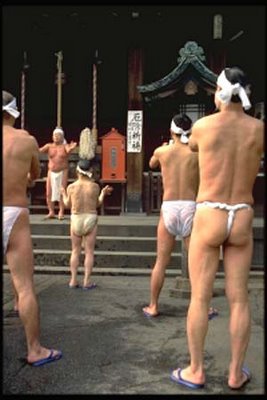
It's interesting if you're going, but long, and written by some guy I don't know.
If you're not going, I would skip this.
Winter Madness
Ever wanted to strip off your clothes and run around naked, without the fear of being arrested? Well, come February you will be able to do just that. Eyo Hadaka Matsuri is upon us again. The Naked Man festival is Okayama’s most famous festival, and sees 1000’s of men stripping down in the freezing cold, and then running around chasing a little stick.
The festival originated in the Eisho Era (1504 – 1521), when priests distributed an amulet to coincide with the Lunar New Year. These amulets were very popular, as they were said to be very effective. Large numbers started to descend upon the temple to lay claim to the good fortune the amulet brought – this forced the priests to higher ground so they could distribute it with greater ease. The priests moved onto the balcony, with the crowd thronging below. In time, the amulet was exchanged for a pair of shingi (wooden sticks). They were considered to be sacred sticks, the property of the gods, and was said to bring a year’s good luck. Originally the kanji used for shingi was “true” and “wood”, but the first kanji was later changed to depict treasure.
That was then, and this is now – so what does the modern festival look like?
The action starts around 7:20 with the Boys Hadaka: 1st and 2nd grade boys fight for Mochi (rice cakes), 3rd and 4th graders struggle for Gofukuzutsu (octagonal treasure tube). Then, 5th and 6th grade boys compete for Takarazutsu(treasure tube). Somewhere around 9pm there is an all female Taiko group banging away on their drums, as well as a fireworks display. Shortly after this, the men start their run. No, the participants are NOT fully naked. They wear fundoshi and Tabi. The fundoshi is basically a very long white cloth wrapped around the naked body of a competitor, a kinda “up and over” mess that shields the dangly bits while running and wrestling for the shingi. It looks similar to the loincloths of Sumo wrestlers. Tabi are traditional socks, which have a separate big toe.
The men run through the streets while chanting, and then into the pond by the main gate to cleanse themselves. They then make their way to the main pavilion, where their wishes are shouted out, and then they make their way around the temple grounds, paying their respects to the two deities Senju Kannon and Goousho Daigongen. While running, they are doused by the priests with holy water. Of course the crowd of spectators also joins in by pouring buckets of water on the runners. This whole process is repeated a few times, before settling on the main pavilion.
On the main pavilion, the number of runners gradually increases, and then the pushing and shoving begins. Priests pour water on the crowd below (a welcome relief, believe you me!) and the “wasshoi, wasshoi” chant reaches fevered levels. At 12am, lights are switched off, and the shingi are thrown. Apart from the 2 main shingi, there are extra shingi (of a lesser value) that are also released into the sea of arms and legs below. That is when the fun starts! Lights come back on, and everyone tries to wrestle the shingi away from its holders, which results in 1000’s of bodies writhing, wrestling and fighting for 2 small sticks. Madness! The holders of the shingi try to make their way across the temple grounds, and as far as I know, try to plant the shingi in a bucket of some sort. Of course, this is mere speculation. I have no real idea how a winner is determined, but for most of us, that doesn’t matter. It is all about the 3 or 4 hours of madness.

So you wanna run? What can you expect and what should you do?
A lot of drinking! While dressing up (down?) into your fundoshi, plenty of beer and sake is consumed. Before the event itself, people stand around socializing over a few beers. Of course this is essential to keep you warm and in the right “spirits” for the festival. Be warned though – the organizers say they won’t accept drunk runners (not that that is a deterrent in any way!)
The runners all get together in a tent, then get naked. Your clothes are put away in a bag, and your fundoshi is unwrapped. Very much like a kimono, you cannot put your own fundoshi on, so there are helpers aplenty in the tent.
The fundoshi dressing process will hurt! Basically, the cloth is wrapped around your body, over the dangly bits, and unceremoniously yanked up the crack. Repeatedly. I weigh 100kg, and I was lifted off my feet while some small drunk Japanese dude tied it to my body. Just look at the pic – these are 10m G-strings, and there is only one way to put it on, and that is to ensure that as much of it as possible is as far up your crack as it will go!
- Your tabi will be destroyed by running on cobblestones, into water, through mud, and on tar. Big sizes could be a problem. As with all shoes in Japan, you can find up to 28cm with ease.
- Tattoos are not allowed. However, that problem is easily solved with tape. This rule is not as stringent as it used to be (mainly because many gaijin participate).
- While running, you will be cold. Very cold! The highlight is running into the pond – the water is freezing.
- While on the pavilion / stage, you will be hot. The body heat of 1000’s of runners can be extreme. As I mentioned earlier, the water the priests pour on the crowd is a welcome relief. It is amazing to see steam rising up above the crowd in the middle of winter. I had a heat rash that lasted for weeks after the Matsuri. Or maybe that was just me.
- It is 3 laps around the pool/wish/temple. The pavilion is usually not that crowded early (early being more than an hour before midnight), thus if you want to assure yourself a spot on the pavilion, one way to do it is to get in the middle early, and wait it out for an hour plus.
- While on the pavilion, people push, shove and fight for position. It is not uncommon for fights to break out. People get pushed off the edge of the pavilion, pushed down stairs, trampled and squashed. That said, I do not think that you as a gaijin runner will be a target. Just use your head, and stay in groups. And try to steer clear of fights.
- In the midst of the throng, it is difficult to breathe, as the air is hot and filled with CO2, and it is difficult to expand your ribcage to take in air. Quote from one of last years’ runners: “I was having a tough time breathing in and considered it a 10 out of 10 on my scale of tolerance for being smushed”.
- RAISE YOUR ARMS! When it gets very crowded, put your arms up. Bodies sway every which way like the sea, and if your arm gets caught in one sway and you're swaying in the other direction, it could do some damage. Lift 'em up.
- When people begin to sway due to pushing from the edges of the pavilion, learn to just rely on your sardine-style orientation for support: When you sway just pick up your feet and keep them moving, do not try and plant them for support but rather just lean on all the people around you. You want to make sure your feet are constantly coming with your body, coz if they get stuck and your body keeps swaying/moving, you've got problems and could get pulled under (i.e. people just start moving up on top of you). When the swaying stops, you put down your feet and get ready for the inevitable sway in the other direction from people pissed that they got pushed off the pavilion... This is also why you get in groups with friends: So that if a friend's foot or something gets stuck, others around him can help (sometimes by grabbing his hands, sometimes by making space with their hands/arms).
- The atmosphere is electric, and is charged with everything male. Testosterone is at an all time high. Technically, women are allowed, but I don’t think that any ladies would enjoy being squashed by a crowd of naked men. Again, I could be mistaken.
- I doubt you will win, but stranger things have happened. Last year I caught the shingi, but despite being much larger than most Japanese, it was impossible to hold onto it. I was robbed of it within seconds. I have heard reports of Gaijin actually taking home one of the lesser shingi, so I guess anything is possible. If you do manage it, prepare for a year of good fortune, and the inevitable riches that will follow. According to rumor, some companies pay ridiculous amounts (e.g. $10 000 US) for one of the shingi. So, 頑張って下さい!

- This is an important tip - Tape! Japanese form teams, and the way they distinguish their group from the next is by taping wrists and fingers with different color schemes. Why? Because all you can see are arms and hands, so if they have the same taping configuration, you know that they are friends. You should also just tape your wrists and knuckles anyways to make them stronger to prevent any jams or bending of the wrong way during the entire melee.
- Make friends with a Japanese team and get your group to join them. It's a lot more fun to "wasshoi" around with a bunch of Japanese men that you just formed a bond with over sake in their team tent (yeah, the Japanese team we hooked up with had a nice heated tent that we waited in and drank sake in until the running started for the men)! They might not let you into their "strategy session" beforehand (??? yeah, don't ask, beats me), but when that's done it's fun to drink with them all and comment on each others legs and asses (remember, this is a put-your-guard-down occasion for the Japanese).
- Do not belly flop or back flop into the pool and splash or intentionally splash photographers who are sitting/standing on the far side of the pool on purpose. One of our runners did both last year and almost got yanked out by police. Also, be careful when submerging your head if you have contacts on (might be obvious, but you might also be drunk!) and do not want to lose them. In no circumstances should you wear glasses if you intend to get onto the pavilion. If you are just going to meander around off of it, this could all be done in glasses, but is still dangerous.
- Moving around post-shingi throwing: Since most gaijin are taller than Japanese people, an effective way of moving around after the shingi is thrown is to literally put your arms down in front of you where you want to go, and clothes lining Japanese people and heads in front of your, pull yourself through. It sounds a little rough, but trust me, it is no more contact than usual in the past hour or so, so people won't get really mad at you.
- Good luck, and get yourself in the "shinbun" the next day by being in the middle when the sticks are thrown and all the photographers snap pictures during the dark (the first 2-3 seconds although the lights are all turned off, you can see people moving in a strobe-like effect due to all the camera flashes going off from photographers in the awnings... very cool).
- Lastly, black fundoshi. Do not in any way mess with these people. These are most likely yakuza or other bad blood, and they are not meant to be teased, taunted, or anything else. Anyone that might have a tattoo (they don't catch / tape them all, I saw some walking around last year), yeah, stay away from them.
Despite all my warnings and advice, this event truly is awesome, and defies belief. It borders on insanity, but that is precisely why it is fun. It offers the normally reserved Japanese a chance to fully unwind. I would strongly recommend trying this at least once.

2 comments:
u are so the best poster around k , well done , i will update mine today hopefully with pics 2
Yeah, I have MASTERED the unique art of cut and paste.
You dam well better update. God dammit.
Post a Comment